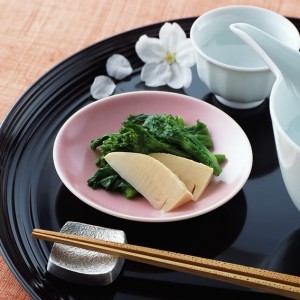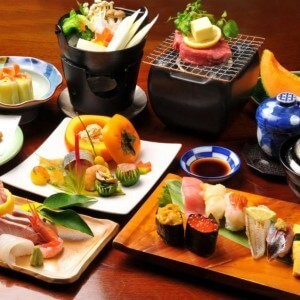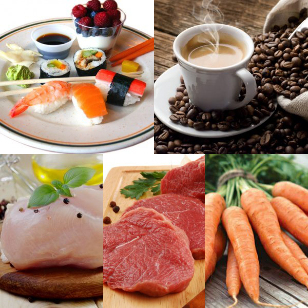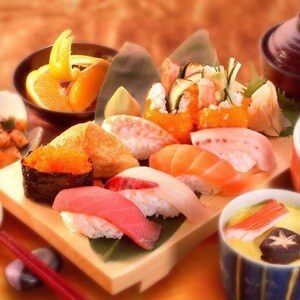
The Japanese diet is a low-calorie diet developed by Japanese nutritionists, whose protein menu allows you to lose about 10 pounds in 2 weeks.
Today, due to being overweight, most people call it a paycheck for an incredibly fast lifestyle. We are in a hurry to live, to work, to eat. . . After all, what we often say when we run is that God sends. In the 21st century, God is increasingly giving us hamburgers, hot dogs, cheeseburgers and soda. . . “What to do? Don’t waste precious minutes for lunch at a restaurant or what? ! - to cook on your own in the kitchen when the business is "on fire"? Here, they say, there is nothing successful in the world. "This is the part of people who lead an active lifestyle. When your favorite jeans don't fit, when you need to buy a longer belt, choose between a seductive skirt that fits snugly around the waist and an elastic band and an awkward shapeless style, then it's time to make a new excuse. "Yes, in fact - all this, of course, is not the result of poor nutrition, simple. . thick bone. Yes, yes, and there is nothing I can do here, thick bone - it's so, very insidious. , it cannot be stopped.
Now let's look at Japan, a country of great opportunities, the highest level of technological development and an incredible pace of life. If someone doesn’t have time to take a break to eat right, it’s like the Japanese. Surprisingly, however, "thick bones" are rare among the inhabitants of Japan. . . So what's the secret?
In fact, Japanese snacks are low-calorie, protein-rich, almost fat-free and "bad" carbohydrate-free foods. And the main principle of oriental food tradition is moderation. That is why Japanese cuisine is called one of the healthiest foods for the body.
Taking into account the peculiarities of the Eastern diet, a balanced and highly effective diet called Japanese was created. In fact, the menu of this diet includes almost no food from traditional Japanese cuisine. But more than that, it does not provoke everything the body needs, but also the combination of proteins, fats and carbohydrates in the amount needed to make the bones "thicker". There are several diet options, but the most popular is the 14-day Japanese unsalted diet. A proper "Japanese" diet for two weeks will help you lose "thick bones" of no more than 10 kilograms and will keep the result strong for several years.
The Importance of the Japanese Diet
Those who decide to become "Japanese" are patient and refuse to eat for two weeks. For most people, dieting may seem a bit daunting, but the results are not long in coming. But the amazing results will last for several years. The “Japanese wife’s” two-week regimen was only - and ten pounds (sometimes even more - all related to her initial weight), as it were.
So what's the main secret? Why is the Japanese diet better than other diets for a week of weight loss? How can it help you lose weight, since other diets have not worked for you?
It's all about carefully selected foods for the diet menu - they are combined in order to speed up the metabolic process as much as possible. Therefore, it is necessary to follow all the instructions exactly, to eat only those that are "not improved". At first glance, its other products seem to have completely replaced them. It is also not recommended to change menu dates.
For many women, her level of "hunger" is important when choosing a diet, because not everyone can fight against the will of the samurai against their will, especially the old instinct of all living things - hunger. This is why the two-week Japanese unsalted diet is not a “hungry” diet. By sticking to it, chewing a cabbage for a week, drinking low-fat kefir, you will not curse yourself, your overweight and those who invent a diet. A place for interesting and delicious recipes on the menu of the Japanese wife. This diet is especially popular with people whose breakfast consists of only coffee. But those who love meat and fish will have no problem with it. This is the best diet for them.
The essence of the Japanese diet can be explained in just two words - slow and effective.
"Japanese" is a low-calorie protein-fiber diet. Carbohydrates, which are reduced to a minimum in the daily diet, make you lose weight fast - you need energy, and the body begins to process its fat reserves into joules. But one more thing to keep in mind: the diet of a Japanese woman does not allow the body to saturate the whole spectrum of vitamins and minerals. Therefore, in order not to complete the weight loss course in the hospital bed, it is strictly forbidden to go on a diet for a specified period (not more than 14 days).
If you want to feel like a real Japanese, you can use traditional Japanese sticks instead of spoons. They not only express the fairy-tale spirit of the land of the rising sun, but also teach how to eat slowly and in small portions. By the way, this trick is known to many people who support the diet. Slow eating deceives the body and makes you feel full even after eating very little. This is actually a diet for weight loss that the Japanese should teach.

Types of Japanese Diet
The popularity of the Japanese diet among women around the world has led to the emergence of several variants of this system for weight loss. In particular, the parameters of the diet are known:
- Japanese unsalted diet for 7 days;
- for 13 days (most commonly used diet);
- for 14 days (differs from the previous 13-day diet by only one day);
- Japanese woman with green tea;
- Naomi Moriyama's diet.
Proponents of each of these methods call their favorite version a "real" Japanese lady. In addition, many mines have been damaged in previous disputes over the authorship of the diet. Some claim that Japanese nutritionists invented it, while others argue that the system has nothing to do with the East. Whoever is the author of the Japanese diet, the main thing is that it works. Its effectiveness has been experienced by millions of donuts around the planet.
The menu of the Japanese diet for weight loss includes foods with minimal calories, carbohydrates, salts, sugar and confectionery, as well as various alcoholic beverages, so the diet is considered strict. This promotes the rapid breakdown of fat in the body, as the body becomes stressed and has to burn its own fat and calories.
Diet menu for 7 days
The 7-day Japanese diet is an easy version of the traditional Japanese diet, but at the same time, the 7-day diet is the basis of the overall diet.

Expected results: 3-5 kg left.
Disadvantage: There is no guarantee of long-term results, as the body has not yet adapted to the new metabolic system.
Day 1
Daily caloric intake: 700 kcal.
Required products:
- black coffee;
- chicken eggs;
- fresh cabbage (Beijing cabbage / white cabbage);
- tomato juice (ideally freshly squeezed);
- Low fat fish.
Breakfast:
- Black coffee - it's better to prefer espresso, but forget about sugar.
Lunch:
- boiled chicken eggs (can be 2 pieces);
- "Japanese" salad - fresh cabbage and a little vegetable oil, no need to add salt;
- a glass of tomato juice.
Dinner:
- steamed fish - hake, cod, pollock are ideal (part does not exceed 200 grams);
- Japanese salad.
Day 2
Daily caloric content: 1000 kcal.
Required products:
- coffee;
- rusks;
- fish (oily varieties);
- cabbage;
- vegetable oil;
- beef;
- kefir.
Breakfast:
- coffee;
- Buckets - Get a small one that weighs about 30 grams.
Lunch:
- fried or boiled fish - for a variety of fatty acids and additional consumption, it is better to give preference to catfish, salmon, black halibut. Not more than 150 grams in total;
- "Japanese" salad.
Dinner:
- Beef - Boil about 200 grams. Unsalted consumption;
- Kefir - you can swim, but not more than a 200 gram glass.
Day 3
Daily caloric content: 1000 kcal.
Required products:
- coffee;
- courgette / parsnip;
- apple;
- chicken eggs;
- torpok;
- cabbage;
- vegetable oil.
Breakfast:
- Don't forget about the black coffee-sugar moratorium.
Lunch:
- zucchini (in sufficient quantities) or parsley root (also large) - brown in vegetable oil (do not use flour or dough for frying, salt is also prohibited);
- apple - don't pick it up, just limit it to fruit.
Dinner:
- boiled chicken eggs - 2 pieces;
- Boiled beef - restriction of appetite to 200 grams of unsalted meat;
- "Japanese" salad.
Day 4
Daily caloric content: 1000 kcal.
Required products:
- coffee;
- carrot;
- hard cheese;
- chicken eggs;
- apple.
Breakfast:
- unsweetened black coffee.
Lunch:
- carrot - boil, it is allowed to take 3 larger roots;
- a little cheese - choose from hard varieties, limit yourself to 20 grams;
- Raw chicken eggs - one is enough.
All the ingredients for a 4-day lunch can be combined into one meal - salad.
Dinner:
- apple - several fruits are allowed.
In this case, the feeling of hunger will not be as strong as before. Completeness occurs after small portions of food.
Day 5
Daily caloric content: 800-1000 kcal.
Required products:
- carrot;
- lemon juice;
- sea fish;
- juice;
- fruits.
Breakfast:
- Carrot and Lemon Juice - Chop the vegetables and mix with the juice. You can not add sugar. Also on this day in addition to breakfast and coffee.
Lunch:
- fried fish - about 350-400 grams, any type - any of the sea;
- Tomato Juice - For a diet, you should prepare and use it yourself. Weight - no more than 200 grams.
Dinner:
- Fruits - But under no circumstances, especially at bedtime, should you use grapes or bananas of any variety. They underline all the results that have already been achieved.
Day 6
Daily caloric content: 900-1100 kcal.
Required products:
- coffee;
- chicken fillet;
- raw cabbage;
- carrot;
- vegetable oil;
- chicken eggs.
Breakfast:
- unsweetened black coffee.
Lunch:
- chicken fillet - limit the portion to 500 g and remove the skin without skin. Boil in water without adding salt;
- Salad - This is a traditional “Japanese” salad that can be enhanced by adding chopped raw carrots.
Dinner:
- chicken eggs - boil 2 pieces;
- Carrot (you can get a large one) - Grate the raw vegetable and grind the salad with a small amount of vegetable oil (possibly olive oil).
Day 7
Daily caloric content: 700-800 kcal.
Required products:
- tea;
- fruits;
- beef;
- egg;
- cabbage;
- vegetable oil.
Breakfast:
- tea - it is recommended to choose good green varieties rich in useful antioxidants.
Lunch:
- Beef - Boil about 200 grams. Do not use salt or other spices when cooking;
- Fruits - On the last day of the diet, you can have lunch for dessert. But do not forget about the ban on the use of bananas and grapes.
Dinner:
For dinner on this day, you can choose any dinner option from the previous days as a reward for patience. For example, choose beef, eggs and sauerkraut with olive oil.
This will stop the diet for some. For those who opt for longer versions of the Japanese wife, 7-day self-transformation is just the equator.
For those who are not accustomed to eating by counting calories, at first it may seem like a very difficult decision for "Japanese" to lose weight. However, the discomfort is noticeable only in the first days - then the body adapts to small portions of food and begins to eat faster. After 5 days, after a new diet in the body, the structure of the first structure begins to accelerate metabolism - the main goal of any diet is to lose weight, remove excess fluid, the tumor disappears. In parallel, you can use a diet and anti-cellulite massage course to achieve the best results.
Japanese diet for 13 days
The 13-day Japanese diet is the most popular. This version is considered a full course of weight loss.
Expected results. If you are ashamed to follow all the instructions, then at the end of 13 days you will lose 10 kg and about 30 cm (sometimes more).
How is it different from a 7-day selection? In fact, this is a sequel to the easy version of “Japanese Wife”. In other words, you have to live a 7-day “Japanese” life, and on the 8th you have to repeat and start again from the first to the sixth day.

Japanese diet for 14 days
The basis of the 14-day version of the Japanese diet was also a 7-day menu, albeit with some nuances. The main difference from the previous two options is that in the first week you have to stick to the 7-day menu, and in the second week you have to eat according to the same program, but in reverse order. This means that the diet of the eighth day corresponds to the last day of the 7th day, the ninth day to the menu of the 6th day, and the tenth day to the menu of the 5th day. . . And according to this principle, continue until the end of the second week. As a result, complete the last 14-day diet with the diet of the first day of the 7-day version of the "Japanese wife".
From the 8th day of a diet, the detoxification process in the body is activated, and due to the principle of a salt-free diet, excess fluid is removed at the intercellular level and completely eliminates the tumor. Being in the second week of the diet, the body adapts to the new pace of metabolism, which is important. With this, even after switching to a normal diet (as usual - this does not mean eating again in the pool for the upcoming sleep, but also do not need to live in a "starvation" mode), the body, on the contrary, does not gain weight - fat burns as fast as during the diet. This wonderful effect lasts for about 2 years. But only if the diet is properly maintained. Those who have already experienced the work of the "Japanese wife" claim that a year later the diet is over and the weight is adjusted downwards. If you repeat the "Japanese wife" again (but not earlier than six months after the first year), you can actually lose 20 kg of excess weight in a year without any practical effort.
Diet and salt
Have you ever wondered why a more or less effective diet bans salt? According to experts,
1 gram of salt holds one liter of fluid in the body.
This is nothing more than another pound of excess weight. In addition to the false excess weight, with the help of salt, the weight is accumulated not by the fat layer, but by the stagnation of fluid, and the excessive use of salt causes other problems for people. A few days of unsalted food lowers blood cholesterol levels and improves the condition of blood vessels.
Of course, it is impossible to completely eliminate salt from consumption, and it is impossible to do so. However, the menu of the "Japanese wife" contains a certain amount of salt - enough nutrients for the normal functioning of the organs. Organic salt is especially found in some vegetables, fish and meat. Canned fruits and vegetables, smoked meats, and semi-finished products should not be eaten during the diet - they all contain enough table salt.
Green tea
In addition to the classic version of the Japanese diet, there is another option on the menu, which offers the use of green tea instead of coffee. Many nutritionists believe that such a change in the "Japanese wife" is good for the body.
Given that the Japanese diet is based on a protein diet, green tea (especially in its Japanese form) should have a large supply of protein, and in terms of its nutritional value, this drink is not inferior to legumes.
The second plus in favor of green tea is that it contains antioxidants, which protect the body from toxins and promote the elimination of toxins.
Third, for those who are losing weight, the most important thing is that the unique chemical composition of green tea helps speed up metabolism by 4 percent (without green tea you burn 60 calories more per day).
The Japanese Tea Diet lasts for 2 weeks. The components are practically the same as in the classic version of the "Japanese", but still have the best features.

Dietary Menu of Japanese Tea Tea
Day 1 / Day 14
Breakfast:
- green tea - a glass;
- nonfat cottage cheese - 150 g.
Lunch:
- cabbage, cooked in oil - 300 g;
- boiled chicken eggs - 2 pieces;
- fresh apple - a glass.
Dinner:
- vegetables in salads or steamed;
- boiled or steamed fish - 200 g.
Day 2 / Day 13
Breakfast:
- green tea - a glass;
- hard cheese - 2 pieces;
- toast or diet cookies.
Lunch:
- boiled or raw cabbage, seasoned with oil;
- cooked fish;
- green tea - a glass.
Dinner:
- vegetable salad;
- boiled beef - 300 g;
- boiled chicken eggs - 2 pieces;
- Japanese green tea - a glass.
Day 3 / Day 12
Breakfast:
- Japanese green tea - a glass;
- dietary cookies.
Lunch:
- boiled zucchini / cauliflower;
- apple - 1 piece;
- green tea - a glass.
Dinner:
- yellow-green vegetable salad;
- boiled beef;
- Boiled chicken eggs - 2 pcs.
Day 4 / Day 11
Breakfast:
- Japanese green tea - a glass;
- nonfat cottage cheese - 150 g.
Lunch:
- raw chopped carrots with olive oil;
- chicken eggs;
- unsweetened green tea.
Dinner:
- green tea;
- fruits (not grapes and bananas).
Day 5 / Day 10
Breakfast:
- green tea - a glass;
- jam and croutons - 2 pcs.
Lunch:
- cooked fish - 200 g;
- tomato juice - a glass.
Dinner:
- fruit and vegetable salad;
- hard cheese - 2 pieces;
- green tea - a glass.
Day 6 / Day 9
Breakfast:
- rye flour - 2 pieces;
- Japanese green tea - a glass.
Lunch:
- boiled with raw cabbage / olive oil;
- boiled chicken - 400 g;
- Japanese tea - a glass.
Dinner:
- carrots (boiled / raw);
- boiled eggs - 2 pieces;
- unsweetened green tea.
Day 7 / Day 8
Breakfast:
- Japanese tea - a glass;
- cheese (any hard variety) - 2 pcs.
Lunch:
- boiled beef - 200 g;
- cooked / steamed vegetables;
- Sugar-free green tea - a glass.
Dinner:
- fruits - desired;
- Japanese green tea - a glass.
The effectiveness of this version of the Japanese diet is increased by adding green tea to the diet, and the variety and taste of the menu makes it easier to withstand periods of food restriction. Repeat the diet - not after a year. Thus, within two weeks, the results remained significant, and in the future it is advisable to maintain a healthy lifestyle, eliminate smoking and alcohol intake, as well as maintain a healthy diet in everyday life.

Main dishes
No matter which Japanese diet you choose, any of them will have a traditional cabbage salad and boiled meat. These dishes can be prepared in different ways. But keep in mind that they are part of the diet and that the cooking process is a little different from cooking. ordinary dishes.
Make the right Japanese salad:
- Get raw or lightly cooked cabbage (common cabbage or Chinese cabbage).
- Imitate it well.
- Squeeze out excess moisture easily.
- Season the base of the salad with olive or sesame oil. Stir and brew
- .
boiled meat diet
- Prepare the meat. If it is chicken, remove the skin. Beef or beef skin from the film.
- Rinse well with cold water.
- Put the meat in a pot and cover with very cold water.
- When it boils, drain the water, shake the meat, add water again and put it on the fire.
- Cook without spices.
Tip: Add onions, small carrots and some vegetables to the water to improve the taste during cooking. Many people wonder how to replace beef in the Japanese diet. Ice is easy to digest on the menu, but it has the same chemical composition as meat that can be included.
How were the products selected?
Almost all sources state that the list of foods allowed during the Japanese diet is unique and cannot be changed. So what is the secret to this special diet?

Coffee. Many people start their day with this fragrant drink. Tea black ground coffee is served in the traditional breakfast and Japanese diet.
What do you need?
Black coffee, which does not have any strengthening properties, helps the body to wake up faster and start the process of burning calories. Since breakfast is not provided by the diet, the body begins to produce energy by burning - the fat under the skin.
You can add vanilla, dark chocolate or citrus fruits to make your breakfast drink more versatile. Add additional ingredients in small doses.
Cabbage. This vegetable was not chosen by chance for the diet. In addition, cabbage is one of the so-called "minus" calorie vegetables (the body uses more energy than it receives for digestion).
What do you need?
Cabbage, white or Chinese cabbage has a strengthening effect on the walls of blood vessels, lowers cholesterol and cleanses the intestines. For people close to the intestines, it is better to boil the cabbage a little before using it.
Olive oil. A teaspoon of fat added to salads normalizes metabolism and has a beneficial effect on the liver, kidneys and pancreas.
Eggs. This product has good nutritional properties and is an excellent source of proteins, fats and carbohydrates, as well as many vitamins and minerals.
Tomato juice. Nutritionists call it the most useful. The unique chemical composition of tomatoes prevents cardiovascular disease and cancer, accelerates metabolic processes in the body, improves mood and has a beneficial effect on the nervous system. It is well absorbed when added without salt, which is especially important for a salt-free diet.
Fish. It is known for its ability to quickly detoxify toxins and toxins. It is a valuable source of proteins and amino acids. Affects the body as a preventive measure against stroke.
Fruit. Generally, the amount of carbohydrates consumed during the diet should be drastically reduced. However, exclusion from the diet is absolutely unpleasant - they are an important source of energy. The body gets the “right” carbohydrates along with fruits. However, bananas and grapes, which are high in sugar, are good in the diet.

Naomi Moriama's Diet
It's hard to believe in the effectiveness of the Japanese diet, especially for those who decide to use it on their own. But sooner or later many people ask themselves: if there is virtually nothing on the menu, why is this diet called the “Japanese diet”? Traditional dishes for the country of the rising sun. But there is an explanation. According to one version, this original diet is developed by nutritionists from the Japanese clinic "Yaelo".
But there is another version of the "Japanese" created by marketer Naomi Moriyama - in response to Mireille Gilliano, a French woman who authored a book, Why French Women Don't Get Fat. In fact, according to research, the French are not at all slim in the world. Only 3% of obese people live in Japan, 11% in France and more than 32% in the United States. Thus, Naomi adapted her diet and adapted it to her diet.
Food rules from the country of sunrise
Orientals eat almost 100 different foods a week, and their total caloric intake, for example, is a little less than a quarter of the weekly caloric intake of Americans. The only secret of Japanese harmony is a simple rule: fill the stomach to 80 percent.














































































